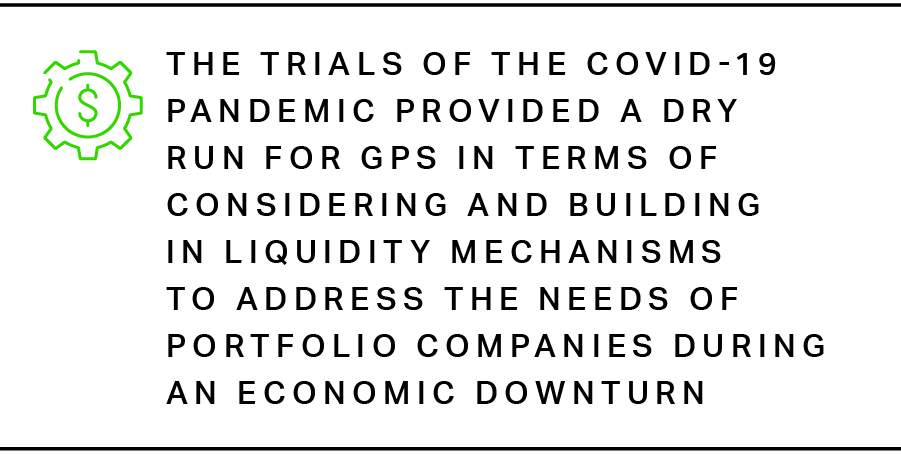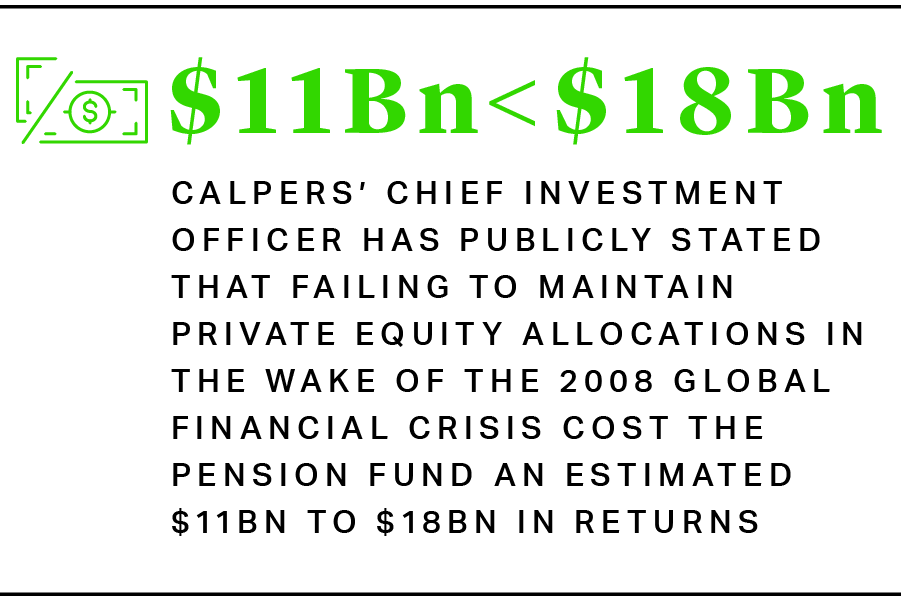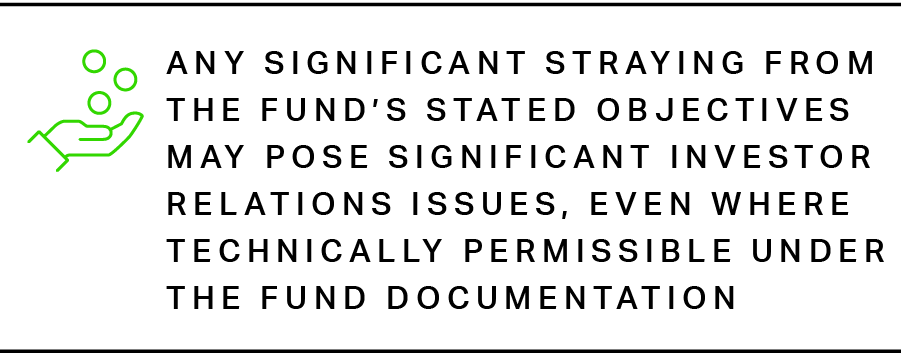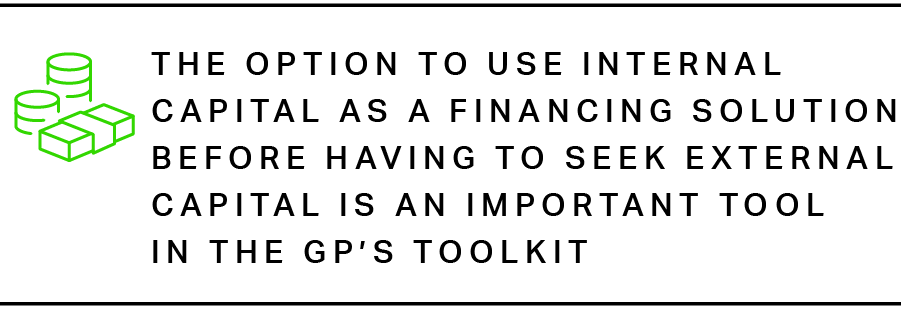Getting Ready for a Recession: Always Be Prepared

Private equity has a long history of flourishing in a downturn. While there are dangers in this type of economic environment, the asset class’s inherent flexibility, long-term investment horizons and alignment of interest mechanisms mean it is ideally positioned to weather shocks and find opportunity amidst the maelstrom. And while it remains to be seen whether current volatility will be short lived or result in a more protracted recession, there are undoubtedly steps that private equity sponsors (“GPs”) can take to ready themselves regardless.
GPs that have not yet explored the myriad innovative liquidity options available, or examined the relevant contractual provisions with regard to these options, should consider doing so now to ensure they are prepared for any challenges that may lie ahead.
In many respects, of course, the trials of the COVID-19 pandemic provided a dry run for GPs in terms of considering and building in liquidity mechanisms to address the needs of portfolio companies during an economic downturn, and for otherwise ensuring that fund documentation provides the flexibility that could prove critical should a deep recession take hold. Many GPs will therefore be cognizant of the levers available to them, for example, for prolonging the lifespan of closed-ended funds, retaining assets and ensuring that the necessary funds are available to keep businesses afloat. That said, even for these GPs it is worth revisiting the analysis in light of today’s current market environment.

In many respects, of course, the trials of the COVID-19 pandemic provided a dry run for GPs in terms of considering and building in liquidity mechanisms to address the needs of portfolio companies during an economic downturn, and for otherwise ensuring that fund documentation provides the flexibility that could prove critical should a deep recession take hold. Many GPs will therefore be cognizant of the levers available to them, for example, for prolonging the lifespan of closed-ended funds, retaining assets and ensuring that the necessary funds are available to keep businesses afloat. That said, even for these GPs it is worth revisiting the analysis in light of today’s current market environment.

Preparing for a Challenging Fundraising Market
Fundraising Prospects
Many institutional investors are only too aware of private equity’s track record of performing well in a downturn.

Nonetheless, as the denominator effect continues to weigh heavily on investors, the pace of fundraising has slowed and become more challenging. Many GPs are actively resetting expectations both internally and externally, including building longer and more flexible fundraising timelines into fund documentation, providing incentives for big and/or early investors (such as fee breaks and co-investment opportunities) and thinking creatively about products that may be attractive to investors in a downturn.

Preparing for a Challenging Fundraising Market
Fundraising Prospects
Many institutional investors are only too aware of private equity’s track record of performing well in a downturn.

Nonetheless, as the denominator effect continues to weigh heavily on investors, the pace of fundraising has slowed and become more challenging. Many GPs are actively resetting expectations both internally and externally, including building longer and more flexible fundraising timelines into fund documentation, providing incentives for big and/or early investors (such as fee breaks and co-investment opportunities) and thinking creatively about products that may be attractive to investors in a downturn.

Terms
Exit markets have also tightened. While the rise of the GP-led secondary transaction will undoubtedly continue in this environment, GPs may also want to explore their ability to extend the life of their funds. Historically, it has been common for a GP to have the right to extend the fund’s term for a set number of years with the consent of investors or the fund’s investor advisory committee (the “LPAC”), with the GP in some cases having the right to extend for an initial number of years unilaterally. GPs may now wish to consider altering fund documentation to provide for longer initial terms, to lengthen the potential extension periods and/or to remove any limit on extensions that investors or an LPAC approve.
GPs may also want to reevaluate their strategies and related investment restrictions and consider whether to include any additional flexibility. Recessions can create unanticipated obstacles and opportunities. GPs should consider not only what investment flexibility is permitted in their fund documents, but also what is expected by their investors. Any significant straying from the fund’s stated objectives may pose significant investor relations issues, even where technically permissible under the fund documentation.

GPs with open-end products will also need to consider their redemption provisions. Are those provisions compatible with the respective fund’s underlying portfolio should the fund or the market in which it invests experience distress? If there is a disconnect, a GP should consider if it can be addressed by rebalancing the portfolio, amending the fund terms or otherwise.

Terms
Exit markets have also tightened. While the rise of the GP-led secondary transaction will undoubtedly continue in this environment, GPs may also want to explore their ability to extend the life of their funds. Historically, it has been common for a GP to have the right to extend the fund’s term for a set number of years with the consent of investors or the fund’s investor advisory committee (the “LPAC”), with the GP in some cases having the right to extend for an initial number of years unilaterally. GPs may now wish to consider altering fund documentation to provide for longer initial terms, to lengthen the potential extension periods and/or to remove any limit on extensions that investors or an LPAC approve.
GPs may also want to reevaluate their strategies and related investment restrictions and consider whether to include any additional flexibility. Recessions can create unanticipated obstacles and opportunities. GPs should consider not only what investment flexibility is permitted in their fund documents, but also what is expected by their investors. Any significant straying from the fund’s stated objectives may pose significant investor relations issues, even where technically permissible under the fund documentation.

GPs with open-end products will also need to consider their redemption provisions. Are those provisions compatible with the respective fund’s underlying portfolio should the fund or the market in which it invests experience distress? If there is a disconnect, a GP should consider if it can be addressed by rebalancing the portfolio, amending the fund terms or otherwise.
Maximizing Liquidity Options
In addition to building flexibility into new funds, many GPs are thinking carefully about managing the cashflow requirements of their existing portfolios.
Subscription Lines and Alternatives
In the first instance, GPs may check their existing fund finance facilities, including terms and duration, as well as whether it is fully committed. This is an exercise that many GPs may already be undertaking given recent turmoil in the banking sector. In light of these developments, GPs should consider whether they have a back-up plan or redundancies in place, should the subscription line counterparty fail.
GPs should also consider to what extent their fund documents would accommodate more innovative financing options. Funds raised post-pandemic that focused on this issue may already include clear language around the use of liquidity tools, but GPs may find that in other funds the documentation may be silent or expressly prohibit some liquidity mechanisms. In other cases, the language may be ambiguous. It is advisable that these GPs, together with their legal counsel, carefully assess what is possible, again keeping in mind investor expectations.

NAV Finance and Preferred Equity
NAV financing and preferred equity are among the most talked about liquidity options available to GPs today. However, even where the fund documentation clearly permits their use, GPs may not always appreciate the time it takes to structure these facilities compared to the typical subscription line, given the increased complexity around collateral. It may be worthwhile for GPs that are interested in these options to proactively initiate dialogue with potential lenders well ahead of any liquidity crunch.
Recycling

GPs should also consider examining the recycling terms in their fund documents and adding additional flexibility where possible. Many have already spent a great deal of time analyzing their ability to utilize distributions for other purposes during the pandemic. The option to use internal capital as a financing solution before having to seek external capital is an important tool in the GP’s toolkit.
Conflict Provisions Related to Rescue Financing
In the event that a portfolio company experiences a liquidity crunch, a GP may also want to provide the portfolio company with an additional cash infusion from the fund’s balance sheet, which may be quicker and easier than third-party financing but could raise conflict of interest issues. For example, a number of the GP’s funds and accounts may have exposure to the same portfolio company, in which case a question may arise regarding which should provide the rescue financing and if one can provide such financing to the benefit of others. GPs should consider checking conflict provisions now to determine which of its managed products would be permitted to provide a capital infusion, should the need arise, and talk to investors in advance regarding the reasons and rationale for any such action.
Managing Litigation Risk in a Downturn
Periods of economic stress are typically associated with increased legal and compliance risk. GPs routinely face difficult judgment calls regarding funds and portfolio companies, and the stakes are heightened in circumstances where funds or the markets in which they invest are experiencing distress. It is important for GPs to keep this in mind, and particularly in the current regulatory climate, GPs may want to review their policies and procedures to ensure they are comprehensive, tailored to the GP’s business and related risks and, perhaps most importantly, are being followed. GPs are well advised to ensure that they are meeting all applicable recordkeeping requirements and that decision-making is carefully documented, to protect against any potential later claims by investors or regulators that question the GP’s business judgment with the benefit of hindsight.
GPs
GPs may want to review their policies and procedures to ensure they are comprehensive, tailored to the GP’s business and related risks and, perhaps most importantly, are being followed.

Downturns undoubtedly create opportunity for private equity but can also present challenges for GPs. Careful preparation and transparent communication will allow GPs to maximize the upside while minimizing risks.


